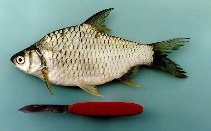| Family: |
Cyprinidae (Minnows or carps), subfamily: Cyprininae |
| Max. size: |
43 cm TL (male/unsexed) |
| Environment: |
benthopelagic; freshwater; depth range - 15 m, potamodromous |
| Distribution: |
Asia: Mekong and Chao Phraya basins, Malay Peninsula, Sumatra and Java (Ref. 27732). Occurs throughout the whole stretch on the Mekong, from the delta around the saline intrusion zone to Chiang Khong in Thailand (Ref. 37770). |
| Diagnosis: |
Dorsal spines (total): 4-4; Dorsal soft rays (total): 8-8; Anal spines: 3-3; Anal soft rays: 6-7. Body is strongly compressed. The back is elevated, its dorsal profile arched, often concave above the occiput. The head is small; the snout pointed; the mouth terminal. The barbels are very minute or rudimentary, especially the upper ones, which sometimes disappear entirely. Color when fresh is silvery white, sometimes with a golden tint. The dorsal and caudal fins are gray to gray-yellow; the anal and pelvic fins light orange, their tips reddish; the pectoral fins pale to light yellow (Ref. 4792). Very few tubercles on the snout which are not visible without magnification; snout length much less than the width of the eye socket (Ref. 37768). Anal-fin with 6-7 branches rays (Ref. 12693). |
| Biology: |
Occurs at midwater to bottom depths in rivers, streams, floodplains, and occasionally in reservoirs. Seems to prefer standing water habitats instead of flowing waters. Inhabits the flooded forest during high water period (Ref. 12693). Feeds on plant matter (e.g. leaves, weeds, Ipomea reptans and Hydrilla) and invertebrates (Ref. 4835). A migratory species but not considered to be a long-distance migrant. Regarded as local migrant which moves from the Mekong up into small streams and canals and onto flooded areas during the rainy season and back again during receding water (Ref. 37770). Some reports indicated that upstream migration of this fish is triggered by the first rains and rising water levels. When it finds a tributary, canal or stream it moves upstream and eventually onto flooded areas. When water recedes, it migrates back into canals and streams and into the Mekong again (Ref. 37770). Often used as a pituitary donor for artificial propagation in aquaculture. Escapees from culture installations have become established in rivers and form the basis for capture fisheries on several Southeast Asian islands (Ref. 1739). Useful in cropping excessive vegetation in reservoirs (Ref. 2686). Used for lap pa (in the preparation of which the numerous small bones are ground fine) or grilled or used to make som pa. Usually marketed fresh and occasionally seen in the aquarium trade (Ref. 12693). A specimen measuring 45 cm TL (2,100 g) was reportedly caught from Dan Tchang Reservoir, Thailand on 8 July 2003 (Jean-Francois Helias, pers. comm., FISHING ADVENTURES THAILAND [mailto:fishasia@ksc.th.com] ). |
| IUCN Red List Status: |
Least Concern (LC); Date assessed: 10 January 2019 Ref. (130435)
|
| Threat to humans: |
harmless |
Source and more info: www.fishbase.org. For personal, classroom, and other internal use only. Not for publication.
